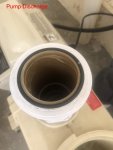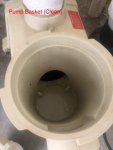Could anyone please help me identify the cause of the straining on the interior walls of the pool piping shown in these pictures?
Our pool was drained to facilitate major maintenance and while removing some of the equipment in the pool shed, I noticed a thin, but stubborn, brownish stain on the interior of some of the pipes. The staining is only on the PVC pipe (Charlotte Pipe brand schedule 40 PVC) and appears to have only affected the suction side of the system before the filter, curiously enough the pump basket and strainer are not stained, and neither are the skimmers, floor drains or eyeball returns, the spa jets are also free of any staining.
Pool water chemistry before drawing was: (TF-100)
FC - 3.5
CC - 0.0
pH - 7.4
TA - 90
CH - 200
CYA - 40
Salt 3300
I have seen several references to iron producing brown stains on pool surfaces, our pool surface was completely free of any straining and the water contains no metals to speak of. These results are from our annual well water analysis, the tests are performed by a licensed laboratory and not a pool store, I also ran the iron test on the pool water itself using the Hanna HI-3834 test from the HACH Pool master kit and results where negative.
Aluminum 0.0
Arsenic 0.0
Barium 0.0327 (limit 0.70)
Cadmium 0.0
Coper 0.0182 (limit 2.00)
Chromium 0.0
Iron 0.0
Magnesium 0.0
Mercury 0.0001 (limit 0.001)
Lead 0.0
Sodium 114.5900 (limit 200)
Zinc 0.0136 (limit 5.00)
The plumbing (as well as the pump, filter, etc.) have been in continuous service for 7 years, while the pool chemistry may have been suboptimal at times in the past, there has never been iron or other metals in our water, and while calcium hardness and scaling has been an ongoing challenge, this does not seem to be related to hard water. The pool did have a Nature 2 system for the first three years, but I abandoned that gimmick 4 years ago, it was installed on the outlet of the filter beyond where the filter outlet picture was taken.
Unless this condition sounds any alarmas with more knowledgable members, I am inclined to ignore it as it does not seem to have caused any issues previously, and cleaning the pipes would be a huge chore, but I was surprised to see it!
Any ideas?






Our pool was drained to facilitate major maintenance and while removing some of the equipment in the pool shed, I noticed a thin, but stubborn, brownish stain on the interior of some of the pipes. The staining is only on the PVC pipe (Charlotte Pipe brand schedule 40 PVC) and appears to have only affected the suction side of the system before the filter, curiously enough the pump basket and strainer are not stained, and neither are the skimmers, floor drains or eyeball returns, the spa jets are also free of any staining.
Pool water chemistry before drawing was: (TF-100)
FC - 3.5
CC - 0.0
pH - 7.4
TA - 90
CH - 200
CYA - 40
Salt 3300
I have seen several references to iron producing brown stains on pool surfaces, our pool surface was completely free of any straining and the water contains no metals to speak of. These results are from our annual well water analysis, the tests are performed by a licensed laboratory and not a pool store, I also ran the iron test on the pool water itself using the Hanna HI-3834 test from the HACH Pool master kit and results where negative.
Aluminum 0.0
Arsenic 0.0
Barium 0.0327 (limit 0.70)
Cadmium 0.0
Coper 0.0182 (limit 2.00)
Chromium 0.0
Iron 0.0
Magnesium 0.0
Mercury 0.0001 (limit 0.001)
Lead 0.0
Sodium 114.5900 (limit 200)
Zinc 0.0136 (limit 5.00)
The plumbing (as well as the pump, filter, etc.) have been in continuous service for 7 years, while the pool chemistry may have been suboptimal at times in the past, there has never been iron or other metals in our water, and while calcium hardness and scaling has been an ongoing challenge, this does not seem to be related to hard water. The pool did have a Nature 2 system for the first three years, but I abandoned that gimmick 4 years ago, it was installed on the outlet of the filter beyond where the filter outlet picture was taken.
Unless this condition sounds any alarmas with more knowledgable members, I am inclined to ignore it as it does not seem to have caused any issues previously, and cleaning the pipes would be a huge chore, but I was surprised to see it!
Any ideas?








